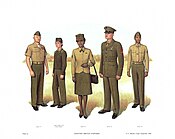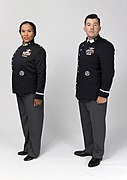The Commendation Medal is a mid-level United States military decoration presented for sustained acts of heroism or meritorious service. Each branch of the United States Armed Forces issues its own version of the Commendation Medal, with a fifth version existing for acts of joint military service performed under the Department of Defense.
The United States has eight federal uniformed services that commission officers as defined by Title 10 and subsequently structured and organized by Titles 10, 14, 32, 33, and 42 of the U.S. Code.
Lieutenant Commander is a commissioned officer rank in many navies. The rank is superior to a lieutenant and subordinate to a commander. The corresponding rank in most armies and air forces is major, and in the Royal Air Force and other Commonwealth air forces is squadron leader. It is roughly equivalent to the Corvette Captain rank in central European countries and the Captain 3rd rank rank in eastern European/CIS countries.
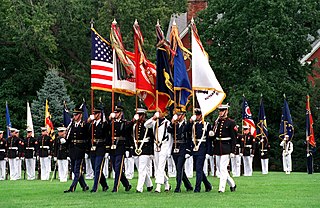
The several branches of the United States Armed Forces are represented by flags. Within the U.S. military, various flags fly on various occasions, and on various ships, bases, camps, and military academies.
In the United States Navy, officers have various ranks. Equivalency between services is by pay grade. United States Navy commissioned officer ranks have two distinct sets of rank insignia: On dress uniform a series of stripes similar to Commonwealth naval ranks are worn; on service khaki, working uniforms, and special uniform situations, the rank insignia are identical to the equivalent rank in the US Marine Corps.
The Achievement Medal is a military decoration of the United States Armed Forces. The Achievement Medal was first proposed as a means to recognize outstanding achievement or meritorious service of military personnel who were not eligible to receive the higher Commendation Medal or the Meritorious Service Medal.
The Air and Space Training Ribbon (ASTR) is the lowest military award of the United States Air Force and United States Space Force, ranking only above foreign military awards.

A service stripe is an embroidered diagonal stripe worn on the sleeve(s) of some military and paramilitary uniforms. In the case of the United States military, service stripes are authorized for wear by enlisted personnel on the lower part of the sleeve of a uniform to denote length of service. Service stripes vary in size and in color.
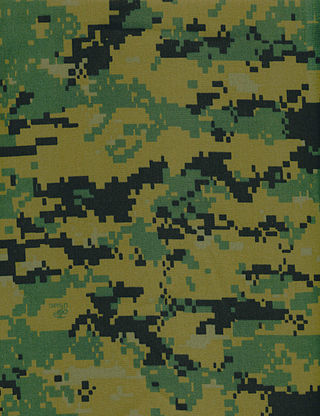
MARPAT is a multi-scale camouflage pattern in use with the United States Marine Corps, designed in 2001 and introduced from late 2002 to early 2005 with the Marine Corps Combat Utility Uniform (MCCUU), which replaced the Camouflage Utility Uniform. Its design and concept are based on the Canadian CADPAT pattern. The pattern is formed of small rectangular pixels of color. In theory, it is a far more effective camouflage than standard uniform patterns because it mimics the dappled textures and rough boundaries found in natural settings. It is also known as the "digital pattern" or "digi-cammies" because of its micropattern (pixels) rather than the old macropattern.

The Battle Dress Uniform (BDU) is a camouflaged combat uniform that was used by the United States Armed Forces as their standard combat uniform from the early 1980s to the mid-2000s. Since then, it has been replaced or supplanted in every branch of the U.S. Armed Forces.

The diver insignia are qualification badges of the uniformed services of the United States which are awarded to servicemen qualified as divers. Originally, the diver insignia was a cloth patch decoration worn by United States Navy divers in the upper-portion of the enlisted service uniform's left sleeve during the first part of World War II, when the rating insignia was worn on the right sleeve. When enlisted rating insignia were shifted to the left sleeve in late World War II, the patch shifted to the upper right sleeve. The diving patch was created during World War II, and became a breast insignia in the late 1960s.

The uniforms of the United States Navy include dress uniforms, daily service uniforms, working uniforms, and uniforms for special situations, which have varied throughout the history of the navy. For simplicity in this article, officers refers to both commissioned officers and warrant officers.

Tiger stripe is the name of a group of camouflage patterns developed for close-range use in dense jungle during jungle warfare by the South Vietnamese Armed Forces and adopted in late 1962 to early 1963 by US Special Forces during the Vietnam War. During and after the Vietnam War, the pattern was adopted by several other Asian countries. It derives its name from its resemblance to a tiger's stripes and were simply called "tigers." It features narrow stripes that look like brush-strokes of green and brown, and broader brush-strokes of black printed over a lighter shade of olive or khaki. The brush-strokes interlock rather than overlap, as in French Lizard pattern (TAP47) from which it apparently derives.

The Airman Battle Uniform (ABU) is a U.S. camouflage combat uniform formerly worn by members of the United States Air Force, United States Space Force, and some civilian employees of the U.S. Department of the Air Force until April 2021. It replaced the Battle Dress Uniform and Desert Camouflage Uniform on 1 November 2011 after a four-year phase-in period.

The Desert Camouflage Uniform (DCU) is an arid-environment camouflage uniform that was used by the United States Armed Forces from the mid-1990s to the early 2010s. In terms of pattern and textile cut, it is identical to the U.S. military's Battle Dress Uniform (BDU) uniform, but features a three-color desert camouflage pattern of dark brown, pale olive green, and beige, as opposed to the four-color woodland pattern of the BDU. It replaced the previous Desert Battle Dress Uniform (DBDU) which featured a six-color "chocolate chip" pattern of beige, pale olive green, two tones of brown, and black and white rock spots. Although completely phased out of frontline use in the U.S. Armed Forces, some pieces and equipment printed in the DCU camouflage pattern are used in limited numbers such as MOPP suits and/or vests.

The United States Marine Corps (USMC) prescribes several types of military uniform to distinguish its service members from other armed services, depending on the situation.
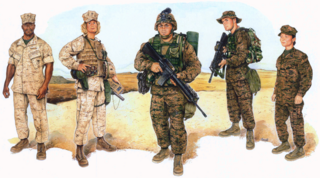
The Marine Corps Combat Utility Uniform (MCCUU) is the current battledress uniform of the United States Marine Corps. It is also worn by Navy personnel assigned to Marine Corps units.

The U.S. Woodland is a camouflage pattern that was used as the default camouflage pattern issued to the United States Armed Forces from 1981, with the issue of the Battle Dress Uniform, until its replacement in the mid to late 2000s. It is a four color, high contrast disruptive pattern with irregular markings in green, brown, sand and black. It is also known unofficially by its colloquial moniker of "M81" after the Battle Dress Uniform it was first used on, though this term was not officially used by the U.S. military.

Operational Camouflage Pattern (OCP), originally codenamed Scorpion W2, is a military camouflage pattern adopted in 2015 by the United States Army for use as the U.S. Army's main camouflage pattern on the Army Combat Uniform (ACU). This pattern officially replaced the U.S. Army's previous Universal Camouflage Pattern (UCP) as the official combat uniform pattern for most U.S. soldiers at the end of September 2019. The pattern also superseded the closely related MultiCam, a pattern previously used for troops deploying to Afghanistan.
The Navy Working Uniform (NWU) is a series of military uniforms that are currently used by the United States Navy for wear by its members. The NWU is a "working" uniform, which means that it is made to a more durable and utilitarian standard, thus being worn in lieu of more formal uniforms that might get unduly damaged or dirtied in the process of normal military duties.






